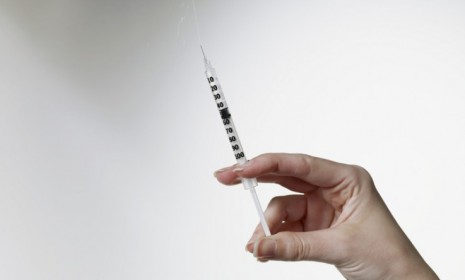The 'groundbreaking' workout you can inject
Scientists identify an injectable hormone that mimics the after-effects of a workout. But don't cancel your gym membership just yet

What if you could experience the benefits of a sweaty workout without lifting a finger? Scientists from the Dana-Farber Cancer Institute and Harvard Medical School have isolated a hormone that floods the muscles after exercise, and have successfully injected it into mice to mimic a workout's positive effects. Could a magic exercise pill be on the horizon? Here's what you should know:
What is the secret behind this injectable workout?
The researchers discovered the hormone hidden inside a complex, little understood molecule that has long been of interest to scientists. They named the hormone irisin, after the Greek goddess Iris, "whose mythic role was to carry messages between gods and humans," says Bill Chappell at NPR. "And like a message telling your body, 'Hey, don't be so fat,'" the hormone tells undesirable "white fat" to transform into healthier "brown fat."
The Week
Escape your echo chamber. Get the facts behind the news, plus analysis from multiple perspectives.

Sign up for The Week's Free Newsletters
From our morning news briefing to a weekly Good News Newsletter, get the best of The Week delivered directly to your inbox.
From our morning news briefing to a weekly Good News Newsletter, get the best of The Week delivered directly to your inbox.
Brown fat? What's that?
It's the most "physiologically desirable" or our body's natural fats, says Gretchen Reynolds in The New York Times. "While white fat cells are essentially inert storehouses for fat, brown fat cells are metabolically active. They use oxygen and require energy. They burn calories." They are prevalent in children, but adults were thought to lose their stores of brown fat until recent studies demonstrated otherwise. The most "groundbreaking" news from this study is that irisin plays a crucial role in determining how much brown fat we have available.
How did the researchers figure that out?
They noted that volunteers who took up regular jogging over several weeks wound up with higher levels of irisin in their systems. And when the scientists injected the hormone directly into the white fat cells of mice, it made those cells more likely to turn into energy-burning brown fat. The mice demonstrated more energy overall and lower body weights than those in another group given a placebo.
A free daily email with the biggest news stories of the day – and the best features from TheWeek.com
So what does this mean?
"Speculating about applications for a hormone that mimics the effect of exercise is easy," says Tiffany O'Callaghan at New Scientist. While the hormone could eventually be used to treat obesity-related issues, it's unlikely to be a substitute for the real thing. "The last thing in the world we're trying to do," says lead researcher Dr. Bruce Spiegelman, "is substitute for diet and exercise."
Sources: Medical Xpress, New Scientist, NY Times, NPR


